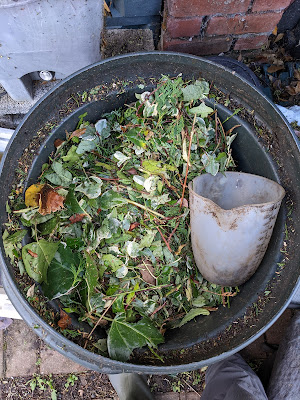I am approaching this interesting question from an energy-efficiency and carbon-intensity viewpoint. Firstly, some basic considerations on how to minimise running costs and environmental impact:
- Step 1: Make sure your appliances are as environmentally friendly as possible. We have a LG A+++ washing machine (6½ years old) and a Beko Heat Pump A++ tumbler dryer (5½ years old). They've been trouble-free but we would look to repair them should anything go wrong. Because most of your carbon footprint per wash is embodied emissions in the manufacture of white goods, it is always best to keep your appliances for as long as possible, even if it is less efficient.
- Step 2: Run as low a temperature wash as you can; 30 ℃ washes are de rigeur in this household but see Step 5.
- Step 3: Use a washing line to dry your laundry whenever possible. When we use the condensing tumble dryer, we collect the 'distilled water' - conductivity 10-20 microsiemens - and re-use for watering plants, rinsing out test vials used for river testing and topping up the Campervan's windscreen washer bottles. Laundry items, particularly towels, can be a little rough and scratchy when air-dried on a washing line especially on a hot sunny day. You can either let them soften with use (my preferred option), use fabric conditioner/softener (see Step 4), or give the air-dried clothes a few minutes in the tumble dryer.
.JPG)
- Step 4: Use environmentally-friendly washing products wherever possible. Often this means avoiding detergents and soaps that contain phosphates. Rivers passing through urban settlements often see a spike in phosphate levels due, in part, to detergent use by the local population. We source our cleaning products from BigGreenSmile but there are plenty of other options. The use of fabric softeners/conditioners seems to be a little controversial with both pros and cons (see Step 3)
- Step 5: Launder as infrequently as possible. As a general rule, clothes worn next to the skin are worn once before washing while outer garments can be worn many times before washing. For us, a light and dark wash at 30 ℃ every week suits our needs. There are varying opinions on how often to launder bedding and towels; we opt for weekly on a 40 ℃ wash cycle.
There are two primary reasons why I choose to do the laundry on a sunny day. Firstly, the running costs are nil (or virtually nil) and the electricity used is zero carbon-rated because it is generated from my rooftop photovoltaic (PV) panels. There is a third reason; it is easier to dry the washing outdoors on a sunny day, ideally with a gentle breeze. In late Spring, Summer and early Autumn, it is usually possible to wait for the right sort of day and I'm more than happy to procrastinate if tomorrow's weather forecast is more promising.
To give some idea of how carbon-intensive washing your stuff can be, I consulted to my copy of How Bad Are Bananas by Mike Berners-Lee plus some manufacturer's specifications. I have excluded the embodied emissions from the manufacture of the appliances (about 270 g CO2e per wash per appliance), as we cannot do anything about them and they are the same for everyone. Estimated carbon footprints for a full wash load are:
0g CO2e if washed at 30 ℃ & dried on a washing line on a sunny day (thanks to our PV panels)
60g CO2e if washed at 30 ℃ & dried on a washing line using typical UK grid electricity
0g CO2e if washed at 60 ℃ & dried on a washing line on a sunny day (thanks to our PV panels)
320 g CO2e if washed at 60 ℃ & dried on a washing line using typical UK grid electricity
0g CO2e if washed at 30 ℃ & dried in heat pump tumble dryer on a sunny day (thanks to our PV panels)
1kg CO2e if washed at 40 ℃ & dried in heat pump dryer using typical UK grid electricity
Note 1: For my calculations, a carbon footprint is 0g CO2e means the financial cost is also zero.
Note 2: from April to September, the output from my PV panels on a sunny day is sufficient to run either the washing machine or the heat pump drier as well all the other household equipment working in the background. Best not to switch the oven on at the same time, though.
On a sunny day in early January, PV output is typically about 1.5 kWh. About 0.5 kWh is background electricity use, leaving only 1 kWh for washing and drying. Apart from the heating stage, this is sufficient for the washing stage; even if it is sunny and cold then you can still air dry outside to remove most of the water before finishing off in the tumble dryer or using an indoor clothes airer.
Note 3: These carbon footprints will reduce as the % renewables that make up the Grid increase. How Bad Are Bananas used a carbon impact of 340 g CO2e for each kWh generated for the UK Grid. That was over two years ago. Emissions data from NationalGrid:Live indicates this figure has already dropped to around 200 g CO2.
So, we have established that doing the laundry on a sunny day is best in terms of cost and carbon impact. But, what if the day is not sunny? Do we have any options other than to 'bite the bullet' and carry on regardless?
It was this question that first entered my consciousness on the final day of October, last year (2022). I was contemplating 'putting a wash on' but the weather that October day was not a good day for laundering. It was cloudy with the promise of drizzle all day, and the weather forecast for the following day was no better! If we were going to make that day a wash day then it would not be a zero-cost, zero-carbon wash. Clearly, I could do nothing about the cost but maybe I could keep my carbon footprint as light as possible by choosing a time of day when renewable (wind, solar, hydroelectric) and low-carbon (nuclear, pumped hydro, biomass) energy sources were in the ascendency for the UK Grid.
Time to refer to a couple of excellent websites giving current information on how the electricity is being generated in the UK. Gridwatch has been going for a good many years ...
while
National Grid: Live run by Kate Morley is a more recent, but very welcome, addition. Having started out with the former, I now tend to use the latter because I prefer its layout especially on mobile devices.
Both websites give current and historical data on generation source, levels, costs, emissions, etc.
Anyway, back to the laundry which wasn't going to wash itself. Having checked National Grid:Live beforehand, I delayed putting the laundry wash on until 10.43 pm when generation sources for the UK Grid comprised renewables (53.0%), low-carbon (22.6%), Imports (2.7%, mainly hydro from Norway and nuclear from France if I remember correctly) and Fossil Fuels (21.7%).
From a carbon footprint point of view, it is often better to use electricity overnight when demand is lowest and the 'renewables' element is a higher proportion of the overall electricity generation. If you can access a variable tariff, you may also find it is cheaper overnight. The screenshot below from NationalGrid:Live shows the price per MWh was actually negative between 0130 - 0230 and 0430 - 0730.
At some time in the not-too-distant future, flexible tariffs will become widely available (smart meter required) that will pay you to use electricity at certain times of the day or night when supply outstrips demand. On the downside, you will be charged more for using electricity at peak demand times so you may need to become more organised if you want to save/make some money.
For electricity generation to have a significant renewable content at night, the wind does have to blow cos the sun don't shine. So, sometimes sun is best for Laundry Day but wind can also be best.
The ideas posited in this post also apply equally well to dishwashing.
At some point in the not-too-distant future, I'm sure humanity will finally accept it has to wean itself off the finite resource that is fossil fuels. The recent increase in the cost of gas - primarily down to that bully-in-chief, Putin - has brought some politicians to their senses a little quicker than expected. I am now expecting to see a big increase in renewable energy investment and R&D in the coming years. We can all help by economising on our energy usage wherever possible and helping that shift to renewables.



















%20vs.%20Date.png)


.png)
.png)







.JPG)







%20vs%20HDDs%20for%20Main%20House,%20Annexe%20and%20Combined%20.png)


%20Correlation.png)





